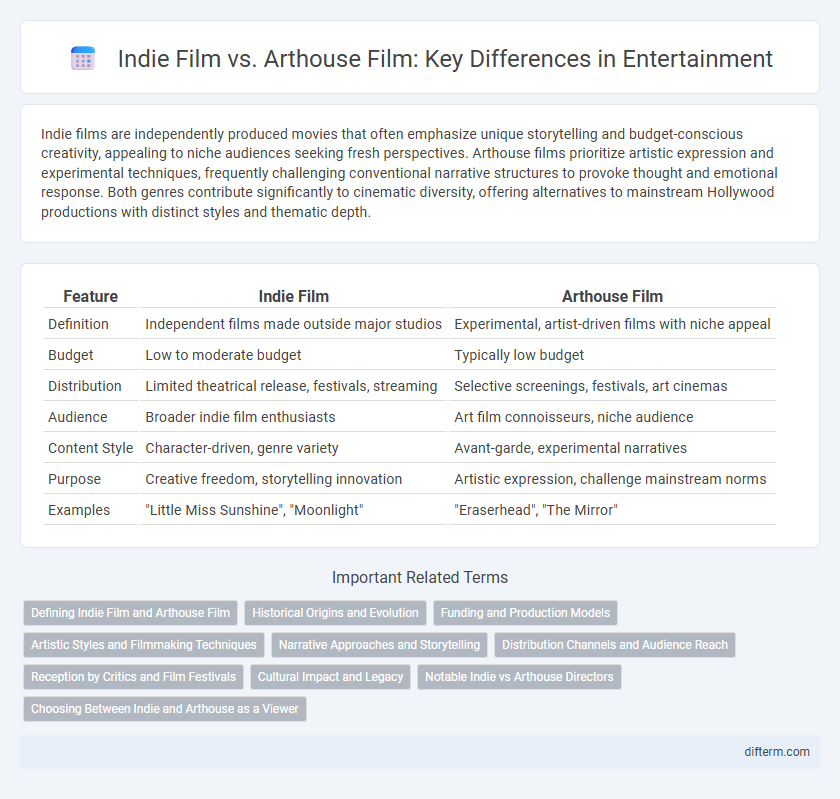Indie films are independently produced movies that often emphasize unique storytelling and budget-conscious creativity, appealing to niche audiences seeking fresh perspectives. Arthouse films prioritize artistic expression and experimental techniques, frequently challenging conventional narrative structures to provoke thought and emotional response. Both genres contribute significantly to cinematic diversity, offering alternatives to mainstream Hollywood productions with distinct styles and thematic depth.
Table of Comparison
| Feature | Indie Film | Arthouse Film |
|---|---|---|
| Definition | Independent films made outside major studios | Experimental, artist-driven films with niche appeal |
| Budget | Low to moderate budget | Typically low budget |
| Distribution | Limited theatrical release, festivals, streaming | Selective screenings, festivals, art cinemas |
| Audience | Broader indie film enthusiasts | Art film connoisseurs, niche audience |
| Content Style | Character-driven, genre variety | Avant-garde, experimental narratives |
| Purpose | Creative freedom, storytelling innovation | Artistic expression, challenge mainstream norms |
| Examples | "Little Miss Sunshine", "Moonlight" | "Eraserhead", "The Mirror" |
Defining Indie Film and Arthouse Film
Indie films are independently produced movies characterized by lower budgets, creative freedom, and storytelling that often explores unconventional themes and niche audiences. Arthouse films emphasize artistic expression, avant-garde techniques, and intellectual narratives designed to challenge mainstream cinematic conventions. Both formats prioritize originality, but indie films focus on independent financing while arthouse cinema targets experimental and thought-provoking content.
Historical Origins and Evolution
Indie films emerged in the 1980s as a response to major studio dominance, emphasizing low-budget production and creative freedom, distinct from arthouse films which trace their roots to European cinema movements of the early 20th century focused on experimental narrative and visual style. Arthouse cinema evolved through movements like Italian Neorealism and the French New Wave, promoting auteur-driven storytelling and artistic innovation. Indie films have since grown to encompass diverse genres and narratives, often distributed through film festivals and digital platforms, reflecting cultural shifts and technological advancements in the entertainment industry.
Funding and Production Models
Indie films typically rely on private investors, crowdfunding, and small production companies for funding, allowing for greater creative control but tighter budget constraints. Arthouse films often receive support from grants, film festivals, and cultural institutions, enabling more experimental storytelling with modest but stable financing. Both models emphasize artistic vision over commercial appeal but differ in their financial structures and production scale.
Artistic Styles and Filmmaking Techniques
Indie films often emphasize raw storytelling and experimental narrative structures, utilizing handheld cameras and natural lighting to create authenticity and intimacy. Arthouse films prioritize visual symbolism and thematic depth, employing meticulous mise-en-scene, long takes, and striking color palettes to evoke emotional and intellectual engagement. Both styles challenge mainstream conventions but diverge in their aesthetic choices and narrative experimentation.
Narrative Approaches and Storytelling
Indie films often emphasize character-driven narratives with raw, authentic storytelling that explores personal and unconventional themes, while arthouse films prioritize experimental and visually symbolic storytelling techniques to challenge traditional narrative structures. Indie filmmakers typically use intimate settings and dialogue-heavy scenes to create emotional resonance, whereas arthouse films employ abstract imagery, nonlinear timelines, and metaphorical elements to provoke intellectual engagement. Both approaches push creative boundaries but differ in their balance between accessibility and artistic expression.
Distribution Channels and Audience Reach
Indie films often rely on digital platforms like Vimeo On Demand, Amazon Prime, and festival circuits for distribution, targeting niche audiences seeking fresh and innovative storytelling. Arthouse films typically use specialized theaters, film festivals such as Sundance or Cannes, and boutique streaming services like MUBI to access cinephiles who appreciate artistic and experimental cinema. While both genres attract dedicated followings, indie films generally achieve broader online reach, whereas arthouse films maintain exclusive appeal through curated exhibition spaces.
Reception by Critics and Film Festivals
Indie films often receive praise for their original storytelling and raw authenticity, appealing to critics seeking fresh perspectives. Arthouse films tend to garner acclaim for their experimental techniques and thematic depth, frequently showcased at prestigious festivals like Cannes and Venice. Both categories benefit from niche festival circuits that prioritize artistic merit over commercial success, influencing critical reception substantially.
Cultural Impact and Legacy
Indie films often challenge mainstream narratives by fostering diverse voices and experimental storytelling, significantly shaping contemporary cultural discourse. Arthouse films emphasize artistic innovation and intellectual engagement, frequently leaving a lasting legacy within cinema history and academic study. Both forms contribute to cultural impact by pushing cinematic boundaries and influencing future filmmakers.
Notable Indie vs Arthouse Directors
Notable indie directors like Shane Carruth and Kelly Reichardt are celebrated for their handcrafted, low-budget films emphasizing unique storytelling and character-driven narratives. In contrast, arthouse directors such as Wong Kar-wai and Lars von Trier specialize in visually poetic, experimental cinema that often explores complex themes and artistic expression. Both spheres contribute distinct styles to entertainment, with indie films prioritizing innovation in narrative form and arthouse films pushing boundaries in cinematic aesthetics.
Choosing Between Indie and Arthouse as a Viewer
Choosing between indie and arthouse films depends on a viewer's preference for narrative style and artistic expression. Indie films often emphasize innovative storytelling and emerging talent, offering fresh perspectives within accessible formats. Arthouse films prioritize experimental techniques and intellectual themes, appealing to audiences seeking deeper, thought-provoking cinematic experiences.
indie film vs arthouse film Infographic

 difterm.com
difterm.com